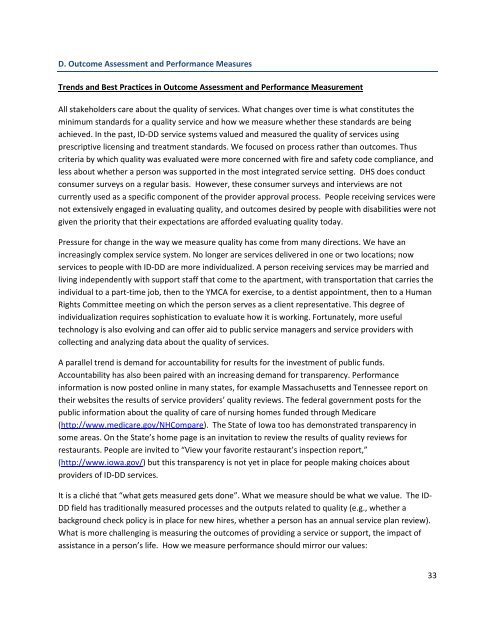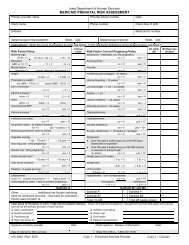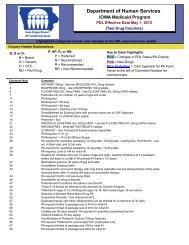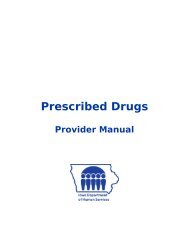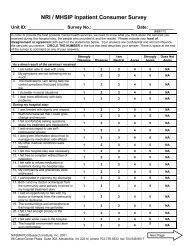Iowa Mental Health and Disability Services System Redesign Interim ...
Iowa Mental Health and Disability Services System Redesign Interim ...
Iowa Mental Health and Disability Services System Redesign Interim ...
- No tags were found...
You also want an ePaper? Increase the reach of your titles
YUMPU automatically turns print PDFs into web optimized ePapers that Google loves.
D. Outcome Assessment <strong>and</strong> Performance Measures<br />
Trends <strong>and</strong> Best Practices in Outcome Assessment <strong>and</strong> Performance Measurement<br />
All stakeholders care about the quality of services. What changes over time is what constitutes the<br />
minimum st<strong>and</strong>ards for a quality service <strong>and</strong> how we measure whether these st<strong>and</strong>ards are being<br />
achieved. In the past, ID-DD service systems valued <strong>and</strong> measured the quality of services using<br />
prescriptive licensing <strong>and</strong> treatment st<strong>and</strong>ards. We focused on process rather than outcomes. Thus<br />
criteria by which quality was evaluated were more concerned with fire <strong>and</strong> safety code compliance, <strong>and</strong><br />
less about whether a person was supported in the most integrated service setting. DHS does conduct<br />
consumer surveys on a regular basis. However, these consumer surveys <strong>and</strong> interviews are not<br />
currently used as a specific component of the provider approval process. People receiving services were<br />
not extensively engaged in evaluating quality, <strong>and</strong> outcomes desired by people with disabilities were not<br />
given the priority that their expectations are afforded evaluating quality today.<br />
Pressure for change in the way we measure quality has come from many directions. We have an<br />
increasingly complex service system. No longer are services delivered in one or two locations; now<br />
services to people with ID-DD are more individualized. A person receiving services may be married <strong>and</strong><br />
living independently with support staff that come to the apartment, with transportation that carries the<br />
individual to a part-time job, then to the YMCA for exercise, to a dentist appointment, then to a Human<br />
Rights Committee meeting on which the person serves as a client representative. This degree of<br />
individualization requires sophistication to evaluate how it is working. Fortunately, more useful<br />
technology is also evolving <strong>and</strong> can offer aid to public service managers <strong>and</strong> service providers with<br />
collecting <strong>and</strong> analyzing data about the quality of services.<br />
A parallel trend is dem<strong>and</strong> for accountability for results for the investment of public funds.<br />
Accountability has also been paired with an increasing dem<strong>and</strong> for transparency. Performance<br />
information is now posted online in many states, for example Massachusetts <strong>and</strong> Tennessee report on<br />
their websites the results of service providers’ quality reviews. The federal government posts for the<br />
public information about the quality of care of nursing homes funded through Medicare<br />
(http://www.medicare.gov/NHCompare). The State of <strong>Iowa</strong> too has demonstrated transparency in<br />
some areas. On the State’s home page is an invitation to review the results of quality reviews for<br />
restaurants. People are invited to “View your favorite restaurant’s inspection report,”<br />
(http://www.iowa.gov/) but this transparency is not yet in place for people making choices about<br />
providers of ID-DD services.<br />
It is a cliché that “what gets measured gets done”. What we measure should be what we value. The ID-<br />
DD field has traditionally measured processes <strong>and</strong> the outputs related to quality (e.g., whether a<br />
background check policy is in place for new hires, whether a person has an annual service plan review).<br />
What is more challenging is measuring the outcomes of providing a service or support, the impact of<br />
assistance in a person’s life. How we measure performance should mirror our values:<br />
33


